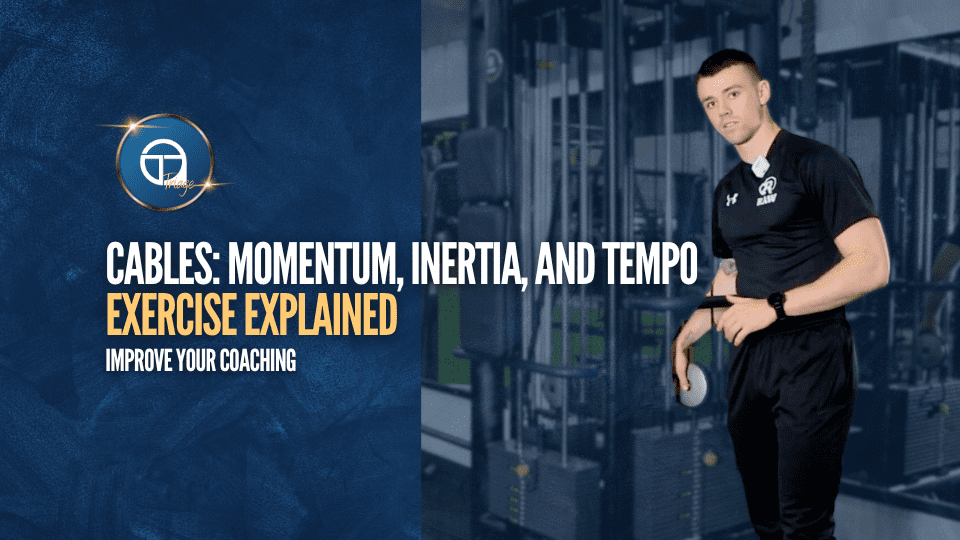Momentum and inertia may not be things you typically think about when you are designing a training program or are actually performing an exercise. However, momentum and inertia are actually quite important things to consider when discussing exercise. So, while this article is going to be quite specific, and something that might seem like splitting hairs at first, it is actually quite applied and quite relevant in terms of programming resistance training and at least understanding what’s going on when we’re training. There are many different discussions that we can have, and will have, in relation to cables and the redistribution of cables and how that affects the magnitude of the resistance and things like that, especially as it relates to some of the more complicated machines.
Understanding Momentum and Inertia On Cable Machines
One of the things I want you to get out of this article, in particular, is how the cable setup itself affects the amount of inertia from the weight that you’re using, and how momentum and inertia interplay when performing exercises on different cable machines. We can think of inertia very simply as the tendency for a weight that is moving to keep on moving. So if I perform a tricep cable pressdown and begin to move the weight, I initially have to overcome the inertia of the weight wanting to simply stay in place. But once it gets going, and especially if I lift it really fast, it’s easy to keep it going because it’s already starting to accelerate in that upright direction. And because it’s accelerating upwards, it’s really easy for me to just swing through the movement to completion, despite not actually requiring the muscles to work excessively hard (outside of that initial overcoming of inertia).
Now, with a cable that has a one-to-one relationship between the distance you move the handle and the distance that the weight moves through space, it is very easy to keep the weight moving and have momentum and inertia doing a lot of the work, rather than the muscles. Whereas if you’ve got a cable set up, that has a mechanism of pulleys that creates a two-to-one relationship, then we are dealing with something entirely different. On some cable stacks, you will have a cable that wraps around a redirecting pulley, and because it wraps around that, what that means is that for every unit of distance that you move the cable, that’s only moving the weight half the distance.
So, as it’s only moving the weight half of the distance, as I begin to move the cable when I’m performing an exercise, then it’s not going to swing around quite as much. As a result, you can start to move that cable more aggressively and still feel the muscles working, because there’s not as much momentum and inertia generated (and you can see this by virtue of the weight not swinging up quite as far as you perform the exercise). As a result, I can perform the exercise with a slightly quicker tempo without it being as easy. Whereas if you’re using a cable with a one-to-one ratio, then you need to be more mindful of the tempo because you have to consider momentum and inertia more.
This is where tempo becomes a little bit more important to consider, because if you’ve got someone who’s trying to get the most out of their triceps, and they’re using tricep rope pressdowns on a cable machine that uses a one-to-one ratio, then they might want to actually be a bit more cognisant of moving quite slowly throughout the range of motion to minimize the effects of momentum and inertia. You don’t want it to just be the case that the weight is bouncing around, because it makes large parts of the exercise quite easy, and when you get to the bottom of the movement, because it is already moving, the weight wants to keep moving, and it feels like you’re doing nothing. Whereas if you move slowly, then you will feel like you’re starting to do a lot more work throughout the range of motion because momentum and inertia are not doing most of the work.
As a rule of thumb: when you’ve got a one-to-one relationship where this cable is going over one pulley and inserting directly into the cable stack, there’s going to be more inertia, and the weight is going to want to move quicker. Thus, you’re typically going to have a situation where someone is able to swing the weight a lot easier. In that case, you will want to use a more controlled tempo. This is different if you’re using a cable stack with a two-to-one relationship, where you’ve got two pulleys, where for every unit that you move the cable itself, the weight stack only moves half the distance. As a result of the two-to-one relationship, there’s less inertia being created, and hence the weight isn’t going to have the same tendency to move through space. This means you can move a little bit quicker without it being just a really easy exercise.
Hopefully, that all gives you some insight into something that can seem quite theoretical and seem like it’s splitting hairs but can actually become relevant. If you’ve got a client and you see that they have a tendency to really start to swing weights around and they’re not getting much out of their triceps or the biceps or whatever the machine happens to be or the cable happens to be, then this could give you some insight into why that is actually taking place and what you could potentially do to remedy it. Hopefully, that gives you guys some things to think about. There’s more to talk about when it comes to cables and changes in resistance, etc. but that’s for future content.
If you do need help with your own training, we do have spaces available for online coaching. If you want to stay up to date with our content, then subscribe to our newsletter and YouTube channel. If you are a coach who wants to upskill, or someone who wants to learn how to coach nutrition, then you may be interested in our Nutrition Coaching Certificate.

Gary McGowan
Hey, I am Dr Gary McGowan, co-founder of Triage, qualified Doctor, Physiotherapist, and Coach.
Having graduated with first class honours in Physiotherapy (BSc) and Medicine (MB BCh BAO), I aim to blend medical science with a decade of coaching experience to help you maximise your performance, transform your body, and optimise your health.
I enjoy grappling, hiking, lifting, and other modes of physical training. When I’m not training, I like to read broadly, particularly philosophy, religion, and history. I love the natural world, particularly the mountains & lakes of my hometown Killarney, County Kerry.


